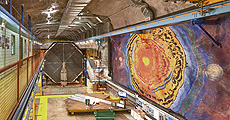Accelerator-based neutrino experiments dig deep to solve mystery of neutrino oscillations
 |
This summer, Fermilab's NOvA neutrino experiment confirmed the oscillation of muon neutrinos into electron neutrinos. Pictured here is the NOvA Far Detector in Ash River, Minnesota. Photo: Reidar Hahn |
The Nobel Prize-winning discovery of neutrino oscillations by the Super-Kamiokande and SNO experiments put a big crack in the highly successful Standard Model of elementary particles and their forces. The historic discovery showed that the Standard Model cannot be the complete theory of the fundamental constituents of the universe, and many questions remain: Why are neutrinos so much lighter than all other matter particles? How do neutrinos get their mass? What is the neutrino mass ordering? How are neutrinos related to dark matter? Do neutrinos and antineutrinos behave differently? And, ultimately, scientists want to know: Are neutrinos the reason matter exists?
Experiments at Fermilab and other laboratories are investigating neutrino oscillations in detail to discover the physics beyond the Standard Model. Using neutrinos created by particle accelerators and nuclear reactors, scientists make measurements that go beyond the original neutrino oscillation results based on cosmic and solar neutrinos.
At Fermilab, the Main Injector Neutrino Oscillation Search began taking data in 2005. A year later, the first MINOS result corroborated earlier observations of muon neutrino disappearance, made by the Japanese Super-Kamiokande and K2K experiments. In the following years, MINOS made detailed measurements of neutrino oscillation parameters.
The NOvA experiment at Fermilab, which began taking data in 2014, released its first neutrino oscillation results earlier this year. While researchers know that neutrinos come in three types, they don't know which is the heaviest and which is the lightest. Figuring out this ordering — one of the goals of the NOvA experiment — would be a great litmus test for theories about how the neutrino gets its mass. While the famed Higgs boson helps explain how some particles obtain their masses, scientists don't know yet how it is connected to neutrinos, if at all. The measurement of the neutrino mass hierarchy is also crucial information for neutrino experiments trying to see if the neutrino is its own antiparticle.
The planned Deep Underground Neutrino Experiment aims to determine whether neutrinos could be the reason that matter exists. It will study neutrinos as they pass 800 miles through the earth and measure whether neutrinos adn antineutrinos behave differently, and help unravel the mystery of why the early universe created more matter than antimatter. The DUNE detectors also will look for neutrinos from a core-collapse supernova. The data would allow scientists to peer inside a newly formed neutron star and potentially witness the birth of a black hole. About 800 scientists from 26 countries are collaborating on DUNE.
The long-baseline neutrino experiments at Fermilab are complemented by a suite of other neutrino experiments dedicated to the search for additional types of neutrinos and studying their interactions with matter.
Fermilab's research on neutrinos is as old as the lab itself. Its first experiment, E1A, was designed to study the weak interaction using neutrinos and was one of the first experiments to see evidence of the weak neutral current. (See the CERN Courier for more details.)
While much of the progress of particle physics has come by making proton beams of higher and higher energies, the most recent progress at Fermilab has come from making neutrino beams of high intensity. Fermilab's flagship accelerator recently set a high-energy neutrino beam world record
when it reached 521 kilowatts. The laboratory is working on improving neutrino beam intensities even further for NOvA, DUNE and other neutrino experiments.
—Kurt Riesselmann
 |
Fermilab neutrino experiment MINOS first witnessed neutrino oscillations in 2006. This is the MINOS Far Detector, located in Soudan, Minnesota. Photo: Reidar Hahn |
|